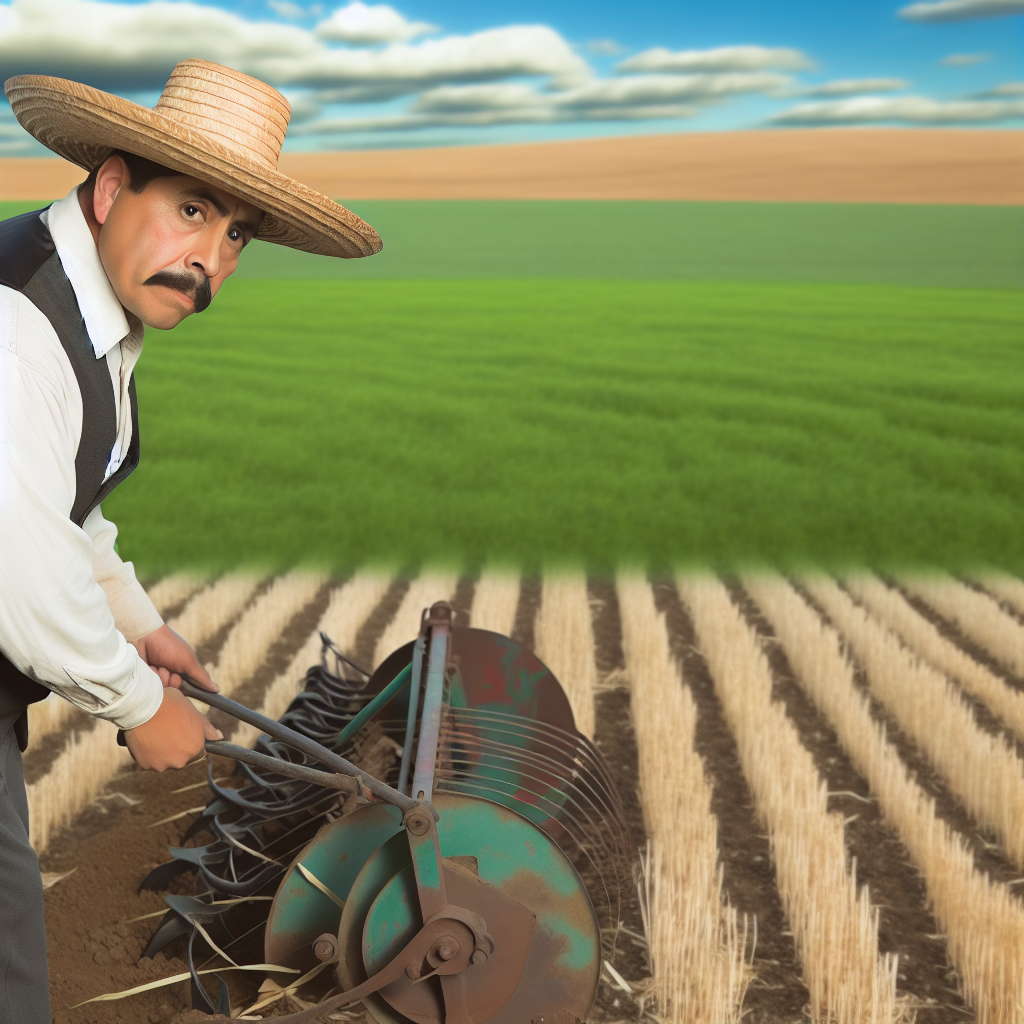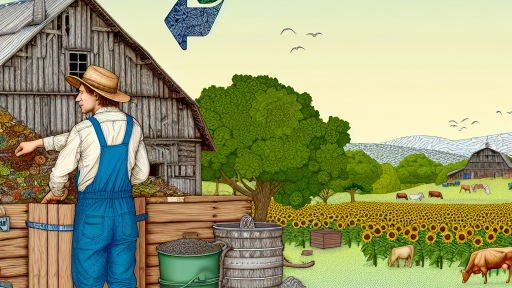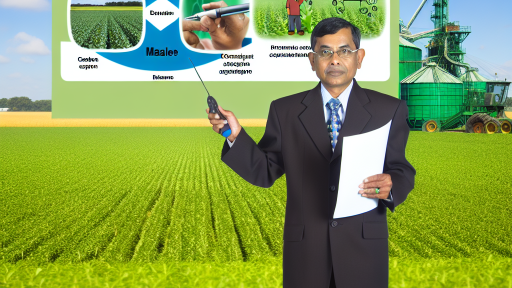Introduction to Conservation Tillage
Conservation tillage refers to farming practices that improve soil health.
It involves reducing soil disturbance compared to traditional plowing techniques.
This method significantly enhances soil structure and fertility.
Furthermore, it helps retain moisture, which is essential for crop growth.
Definition
Conservation tillage encompasses various practices, including no-till and reduced tillage.
No-till farming involves planting crops directly into undisturbed soil.
Reduced tillage uses minimal disturbance to prepare the soil for planting.
This methodology focuses on maintaining soil cover to protect the soil ecosystem.
Importance
Adopting conservation tillage practices offers numerous environmental benefits.
It reduces soil erosion by keeping soil intact.
This practice enhances biodiversity by fostering a healthy ecosystem.
Moreover, it increases carbon sequestration, helping to mitigate climate change.
Benefits for Small Farms
For small farms, conservation tillage can lower operational costs.
It reduces the need for fuel and equipment maintenance.
Additionally, it can improve yields by fostering healthier soil.
Transform Your Agribusiness
Unlock your farm's potential with expert advice tailored to your needs. Get actionable steps that drive real results.
Get StartedThis approach proves essential for sustainable farming and local food systems.
Benefits of Conservation Tillage for Small Farms
Soil Health Improvement
Conservation tillage enhances soil structure significantly.
This practice helps retain moisture, reducing erosion rates.
Moreover, it allows for better root penetration.
Improved soil health results in higher organic matter content.
Consequently, beneficial microorganisms thrive, enriching the soil.
Increased Crop Yield
Farmers often report higher yields using conservation tillage.
Less soil disturbance preserves the natural ecosystem.
Healthy soil leads to robust crop growth and resilience.
As a result, farmers experience fewer crop failures.
Reduced Input Costs
This method can lower operational costs significantly.
Less machinery use translates to decreased fuel consumption.
Additionally, reduced soil erosion minimizes the need for fertilizers.
Thus, farmers save money over time while improving sustainability.
Environmental Benefits
Conservation tillage contributes positively to the environment.
It helps sequester carbon, mitigating climate change impacts.
Additionally, it protects water quality by reducing runoff.
Healthy soil systems filter pollutants before reaching waterways.
Enhanced Biodiversity
This practice encourages a diversity of plant and animal life.
By preserving habitats, farmers promote ecological balance.
Insects and soil organisms play vital roles in agriculture.
The resulting biodiversity supports pest management naturally.
Types of Conservation Tillage Practices
No-Till
No-till farming preserves soil structure effectively.
This method eliminates soil disturbance from plowing.
Showcase Your Farming Business
Publish your professional farming services profile on our blog for a one-time fee of $200 and reach a dedicated audience of farmers and agribusiness owners.
Publish Your ProfileIt retains moisture and reduces erosion significantly.
Crops are planted directly into undisturbed soil.
Cover crops are often used to improve soil health.
Farmers like Laura Jennings have seen improved yields.
This practice enhances biodiversity in soil ecosystems.
Reduced-Till
Reduced-till farming involves minimal soil disturbance.
This practice reduces the frequency of tillage operations.
Farmers can control weeds and maintain soil conditions.
The soil structure remains largely intact using this method.
Using cover crops, farmers enhance nutrient cycling.
John Miller, a small farmer, finds it cost-effective.
Overall, it supports both productivity and sustainability.
Strip-Till
Strip-till combines elements of both no-till and reduced-till.
This method disturbs only a narrow strip of soil.
It allows for targeted planting of seeds with great precision.
The remaining soil areas maintain cover and moisture.
Farmers benefit from improved seedbed conditions.
Sandy Thompson, a local farmer, uses strip-till successfully.
This practice improves the effectiveness of fertilizers.
See Related Content: Top Recycling Practices for Sustainable Agriculture
Choosing the Right Conservation Tillage Method for Specific Crops
Understanding Different Tillage Practices
Conservation tillage practices minimize soil disturbance.
Farmers can implement various methods effectively.
Some popular methods include no-till, reduced-till, and strip-till.
Each method has unique benefits for crop growth.
Choose the right practice based on soil type and climate.
No-Till Farming
No-till farming requires no soil cultivation.
This method retains soil structure and health.
Additionally, it prevents erosion and nutrient loss.
Crops like soybeans and corn thrive under this practice.
Farmers in drier regions benefit more from no-till methods.
Reduced-Till Farming
Reduced-till methods involve limited soil disturbance.
This practice balances soil health with weed control.
It allows for the incorporation of cover crops.
Farmers can utilize this technique for small grains.
Moreover, it supports moisture retention in the soil.
Strip-Till Farming
Strip-till farming prepares narrow strips for planting.
This method conserves soil structure between strips.
Crops such as cotton and vegetables thrive with strip-till.
Strip-till improves soil fertility while minimizing erosion.
Farmers transitioning from conventional methods find this beneficial.
Showcase Your Farming Business
Publish your professional farming services profile on our blog for a one-time fee of $200 and reach a dedicated audience of farmers and agribusiness owners.
Publish Your ProfileEvaluating Crop Needs
Understanding crop needs is essential for success.
Consider factors like root depth, nutrient requirements, and moisture needs.
Crops with deeper roots may benefit from reduced tillage.
If weeds are a concern, no-till may be more effective.
Assessing these factors helps in making informed decisions.
Assessing Soil Health
Healthy soil is crucial for optimal yields.
Farmers should analyze soil composition and structure.
Compacted soils might require less intensive tillage.
A soil test can identify nutrient deficiencies and pH levels.
Ultimately, healthy soil leads to sustainable farming practices.
Delve into the Subject: Sustainable Greenhouse Designs For Year-Round Farming
Implementing Conservation Tillage: Tools and Equipment Needed
Essential Tools for Conservation Tillage
Conservation tillage requires specific tools to be effective.
One key tool is the no-till drill.
This equipment plants seeds directly into undisturbed soil.
Additionally, a conservation tillage implement can be beneficial.
It minimizes soil disturbance while preparing the seedbed.
Another useful tool is a cover crop roller crimper.
This device helps manage cover crops while reducing weed growth.
Choosing the Right Equipment
Select equipment suited to your farm’s specific needs.
Consider the size of your farm when choosing tools.
For small farms, compact equipment may be ideal.
Also, evaluate your soil type before making a decision.
Different soils may require different tillage approaches.
Maintaining Your Equipment
Regular maintenance ensures your tools work efficiently.
Start by inspecting equipment before each use.
Check for wear and make necessary repairs promptly.
Also, keep your tools clean to prolong their lifespan.
Finally, store equipment properly during the off-season.
Understanding Costs and Budgeting
Investing in tools can require significant initial costs.
To manage expenses, create a detailed budget.
Factor in both upfront and ongoing maintenance costs.
Additionally, consider the long-term savings of conservation tillage.
Over time, it can reduce input costs, improving profitability.
See Related Content: Enhancing Soil Health Through Sustainable Farm Planning
Economic Considerations
Cost-Benefit Analysis of Conservation Tillage
Farmers must assess the economic impacts of conservation tillage practices.
A cost-benefit analysis helps evaluate these economic impacts.
This analysis considers both upfront costs and long-term benefits.
Initial Investment Costs
Implementing conservation tillage often requires initial investments.
For instance, purchasing new equipment can be expensive.
Alternatively, retrofitting existing equipment may be necessary.
Showcase Your Farming Business
Publish your professional farming services profile on our blog for a one-time fee of $200 and reach a dedicated audience of farmers and agribusiness owners.
Publish Your ProfileTraining staff in new techniques incurs additional costs.
Initially, farmers may experience lower yields in transition years.
Long-Term Financial Benefits
Despite initial costs, conservation tillage offers many long-term financial benefits.
Farmers can reduce costs associated with fuel and labor.
Moreover, conservation tillage improves soil health over time.
Healthy soil enhances crop productivity and can increase revenues.
Impact on Crop Yield
An important factor in the cost-benefit analysis is crop yield.
While yields may dip during the transition period, they often recover.
In the long run, scientifically backed practices boost overall yield.
Additionally, resilience in extreme weather can improve with better soil health.
Environmental and Social Benefits
Conservation tillage contributes to environmental sustainability.
Reducing soil erosion leads to healthier ecosystems.
Moreover, improving water retention supports local water sources.
Socially, sustainable farming practices enhance community resilience.
Examples from Successful Farms
Consider Emma’s Organic Farm, which adopted conservation tillage.
After two years, she reported a significant reduction in input costs.
Her yields increased, demonstrating the method’s worth.
Additionally, her community benefited from improved soil health.
Overall Economic Value
Conservation tillage presents a holistic economic value.
While the initial investment may be daunting, the returns are notable.
Farmers are advised to consider these factors carefully.
A thorough cost-benefit analysis is crucial.
Learn More: Implementing IPM for Healthier Crop Yields

Environmental Impact
Effects on Erosion
Conservation tillage reduces soil erosion significantly.
This practice helps maintain soil structure and fertility.
Additionally, intact crop residues protect the soil surface.
Consequently, water runoff reduces while moisture retention improves.
Farmers can observe increased soil health over time.
Water Management
Effective water management is critical for small farms.
Conservation tillage enhances water infiltration into the soil.
This allows more water to be absorbed during rainfall.
Moreover, it decreases surface runoff and erosion risk.
Farmers benefit from reduced irrigation needs due to this practice.
Biodiversity Enhancement
Biodiversity plays a vital role in agricultural ecosystems.
Conservation tillage creates a habitat for various organisms.
Decomposers and beneficial insects thrive in no-till fields.
This, in turn, promotes natural pest management.
A diverse ecosystem leads to improved crop resilience.
Hence, adopting these practices is a valuable investment.
Challenges and Limitations of Conservation Tillage in Small Scale Farming
Compacted Soil Issues
Small farmers often struggle with soil compaction.
Showcase Your Farming Business
Publish your professional farming services profile on our blog for a one-time fee of $200 and reach a dedicated audience of farmers and agribusiness owners.
Publish Your ProfileThis issue arises from heavy machinery use.
Compacted soil reduces water infiltration and root growth.
Additionally, it can lead to reduced yields over time.
Weed Management Difficulties
Weeds thrive under conservation tillage practices.
Farmers may find it harder to control weed populations.
This can lead to increased herbicide use.
Moreover, some weeds may develop resistance over time.
Lack of Knowledge and Resources
Many small farmers lack training in conservation tillage.
Without proper knowledge, adopting new practices can be challenging.
Additionally, access to resources and equipment can be limited.
This creates barriers to effective implementation.
Initial Investment Costs
Conservation tillage can require upfront investments.
Farmers need to purchase new equipment or modify existing tools.
Many small farms operate on tight budgets.
This financial strain can discourage the transition to conservation tillage.
Weather and Climate Variables
Weather conditions greatly impact conservation tillage effectiveness.
Excessive rainfall can erode soil without proper management.
Drought conditions may hinder the establishment of cover crops.
These variables complicate predictability in farming outcomes.
Case Studies: Successful Implementation of Conservation Tillage on Small Farms
Introduction to Case Studies
Case studies highlight the effectiveness of conservation tillage.
These real-life examples demonstrate successful practices in various locations.
Farmers learn from the experiences of others in their community.
Example: Green Valley Farm
Green Valley Farm is located in central Ohio.
Owner Sarah Mitchell adopted conservation tillage five years ago.
She noticed increased soil health and improved water retention.
Moreover, her yields remained stable despite less tillage.
Fewer passes with machinery reduced fuel and labor costs significantly.
Example: Sunny Acres Organic Farm
Sunny Acres, a small organic farm in California, implemented no-till practices.
Owner Mark Johnson transitioned to conservation tillage gradually.
He began by using cover crops to improve soil structure.
This method has enhanced biodiversity on his farm.
Mark reports higher earthworm populations, which benefit cropping systems.
Example: Riverview Homestead
Riverview Homestead, situated in Vermont, illustrates integrated approaches to conservation tillage.
Owner Emily Carter combines crop rotation with minimal tillage.
She has seen a reduction in weed pressure as a result.
This practice bolsters local pollinator populations by providing diverse habitats.
Emily emphasizes the economic benefits through reduced herbicide use.
Key Takeaways
Successful conservation tillage enhances soil health and biodiversity.
It reduces costs and labor demands associated with traditional farming methods.
Farmers benefit from stable yields and improved environmental conditions.
Showcase Your Farming Business
Publish your professional farming services profile on our blog for a one-time fee of $200 and reach a dedicated audience of farmers and agribusiness owners.
Publish Your ProfileThese case studies inspire others to adopt similar practices on their farms.
Future Trends in Conservation Tillage and Sustainable Farming Practices
Technological Advancements
Technology continues to evolve in the realm of agriculture.
Farmers increasingly utilize precision agriculture to enhance efficiency.
These technologies include GPS-guided equipment and drones.
Consequently, producers can monitor crop health effectively.
This approach minimizes resource waste and improves yields.
Increased Adoption of Cover Crops
Cover crops play a vital role in sustainable farming.
Farmers are embracing these crops for their soil benefits.
They enhance soil structure and prevent erosion.
Moreover, cover crops suppress weeds naturally.
This practice leads to reduced need for herbicides.
Focus on Soil Health
Soil health remains a priority in modern farming practices.
Farmers are adopting practices that enhance microbial activity.
Healthy soil leads to improved water retention.
This results in better drought resilience for crops.
Additionally, healthy soil supports nutrient cycling.
Policy Support and Incentives
Governments are increasingly supporting conservation practices.
Financial incentives encourage farmers to adopt sustainable methods.
Programs like the Environmental Quality Incentives Program assist producers.
This support is crucial for small farms transitioning to conservation tillage.
Such initiatives boost long-term sustainability in agriculture.
Community Engagement and Education
Community engagement strengthens sustainable farming awareness.
Workshops and seminars provide crucial information to farmers.
Collaboration among local farmers fosters knowledge sharing.
This network can lead to innovative solutions for common challenges.
Additionally, educational programs help raise awareness about practices.
Additional Resources
Adoption of conservation tillage has increased over the past two …
Conservation tillage | Sustainable Agriculture Research & Education …




